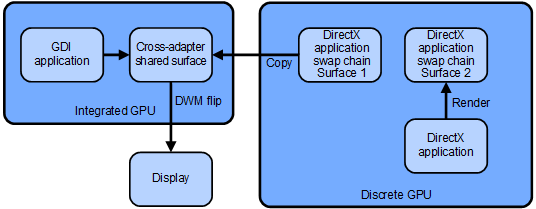Note
Access to this page requires authorization. You can try signing in or changing directories.
Access to this page requires authorization. You can try changing directories.
Starting in Windows 8.1, a discrete GPU uses a cross-adapter resource as:
- A destination for bit-block transfer (bitblt) or present operations, but without stretching or color conversion.
- The resource that the operating system requests the user-mode display driver to perform the bitblt or present operation to and from.
An integrated GPU uses a cross-adapter resource as:
- A texture during composition by the Desktop Window Manager (DWM).
- A render target for GDI hardware acceleration.
- A display primary.
- Not as a render target for 3-D operations.
The following sections describe the architecture and processes involved in three possible scenarios where an application renders on a discrete GPU within a hybrid system.
Redirected bitblt presentation model

- A cross-adapter resource for a top-level window is created in kernel mode as a standard allocation on the integrated GPU.
- When this resource is opened on the discrete GPU, the DirectX graphics kernel subsystem (Dxgkrnl.sys) calls the DxgkDdiGetStandardAllocationDriverData function and creates a new resource on the discrete GPU using the same backing store (mass-storage device) as for the integrated GPU.
- The Direct3D runtime instructs the discrete GPU's user-mode display driver to open the cross-adapter resource using private driver data.
- A DirectX application renders on the discrete GPU to a back-buffer resource. See the "Render" operation in the figure.
- When a DirectX application calls a Present method, the Direct3D runtime calls the PresentDXGI (or pfnPresent) function of the discrete GPU's user-mode driver to copy the back buffer to the cross-adapter resource. See the "Present" operation in the figure.
- When a Windows Graphics Device Interface (GDI) application renders to a top-level window, the DirectX graphics kernel subsystem calls the DxgkDdiRenderKm function of the integrated GPU's display miniport driver and indicates that the cross-adapter resource is a render target. See the connection between the GDI application and the cross-adapter surface in the figure.
- The DWM process opens the cross-adapter resource in the integrated GPU and uses it during composition as a source texture. See the "Composition" operation in the figure.
Direct flip presentation model

- The Direct3D runtime instructs the discrete GPU's user-mode display driver to create a cross-adapter resource for each swap chain surface.
- On the discrete GPU, the Direct3D runtime might set the Primary and VidPnSourceId members of the D3DDDI_ALLOCATIONINFO structure if the Direct Flip mode is available. These member values should be passed when the pfnAllocateCb function is called.
- The Direct3D runtime instructs the integrated GPU's user-mode display driver to open a cross-adapter resource that is to be managed by the DWM.
- An application renders on the discrete GPU using the render target texture as a destination. See the "Render" operation in the figure.
- When an application calls a Present method, the Direct3D runtime calls the BltDXGI (or pfnBlt) function of the discrete GPU's user-mode driver to perform a copy to the cross-adapter resource. The runtime then calls the PresentDXGI (or pfnPresent) function of the discrete GPU's user-mode driver, with source set to the cross-adapter resource and the destination allocation set to NULL. See the "Copy" operation in the figure.
- The DWM performs its composition using the resource from the integrated GPU. If a Direct Flip operation is needed (DXGK_SEGMENTFLAGS.DirectFlip is set), DWM instructs the integrated GPU's display miniport driver to perform a flip operation from one cross-adapter allocation to another. See the "DWM flip" operation in the figure.
Full-screen model
- The Direct3D runtime instructs the integrated GPU's user-mode display driver to create a cross-adapter shared primary allocation for each swap chain surface.
- The Direct3D runtime instructs the discrete GPU's user-mode display driver to open the cross-adapter resources.
- An application renders on the discrete GPU using the render target texture as the destination.
- When the application calls a Present method, the Direct3D runtime instructs the discrete GPU's user-mode display driver to perform a copy to a cross-adapter resource.
- The integrated GPU's user-mode display driver and display miniport driver are instructed to flip to this cross-adapter resource.